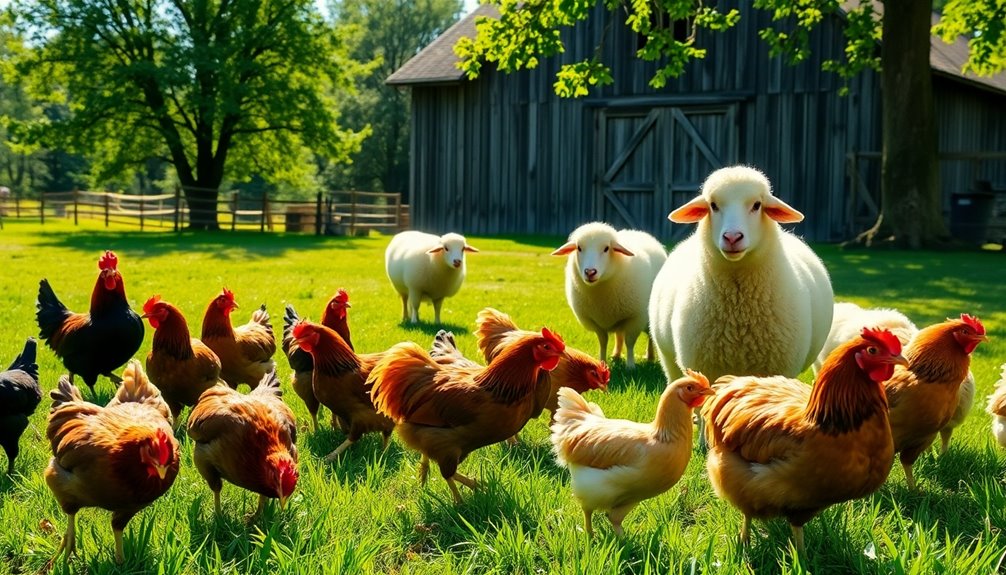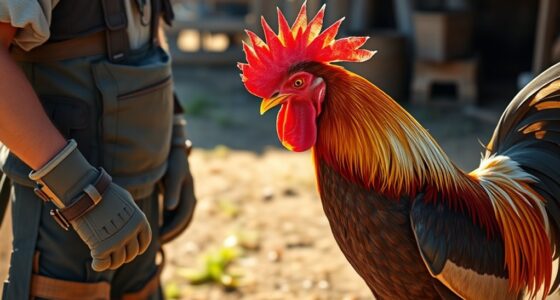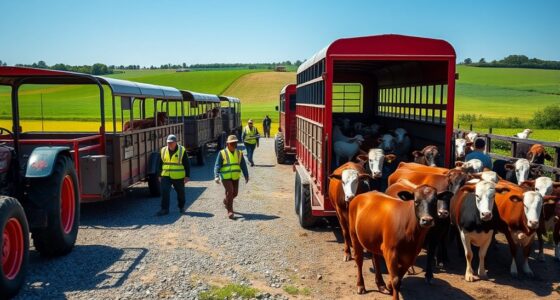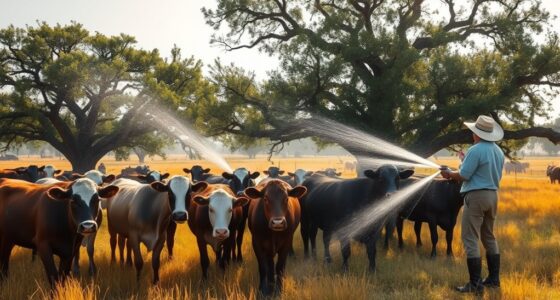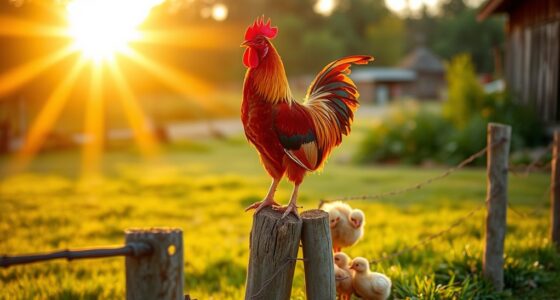If you're looking for dual-purpose breeds that provide both meat and eggs, consider the Rhode Island Red and Buff Orpington chickens. The Rhode Island Red lays about 280 eggs annually and offers substantial meat, while Buff Orpington produces around 250-280 eggs and weighs 8-10 lbs. For sheep, the Icelandic breed is a great option as it provides wool, meat, and milk. These breeds not only enhance your farm's productivity but also contribute to sustainability. There's plenty more to explore about how these breeds can fit into your farming goals and how to care for them effectively.
Key Takeaways
- Dual-purpose chicken breeds like Rhode Island Red and Buff Orpington offer high egg production alongside substantial meat yield.
- Black Australorp is an excellent choice for egg production, yielding up to 364 eggs annually while providing good meat quality.
- Awassi and Icelandic sheep are versatile, providing milk, wool, and meat, making them ideal for small farms.
- Consistent management practices, including balanced diets and health checks, enhance the productivity of dual-purpose breeds.
- Market demand and local climate should guide the selection of specific sheep and chicken breeds for optimal results.
Overview of Dual-Purpose Breeds
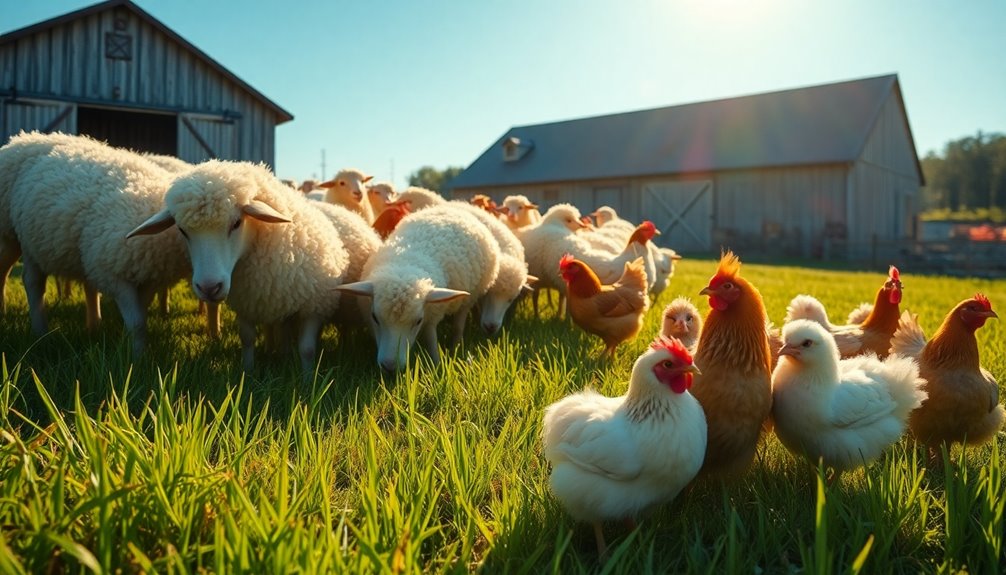
When you're considering adding livestock to your small farm or homestead, dual-purpose breeds can be a game changer. These breeds are specifically bred to provide both high-quality meat and good egg production, making them versatile choices.
For chickens, the Rhode Island Red stands out as a top option, laying up to 280 eggs per year while offering substantial meat. Another excellent choice is the Plymouth Rock, known for its friendly nature and around 260 eggs annually.
When it comes to sheep, breeds like the Awassi provide both milk and wool, while Icelandic Sheep offer tri-purpose benefits with wool, meat, and milk.
Benefits of Raising Dual-Purpose Chickens
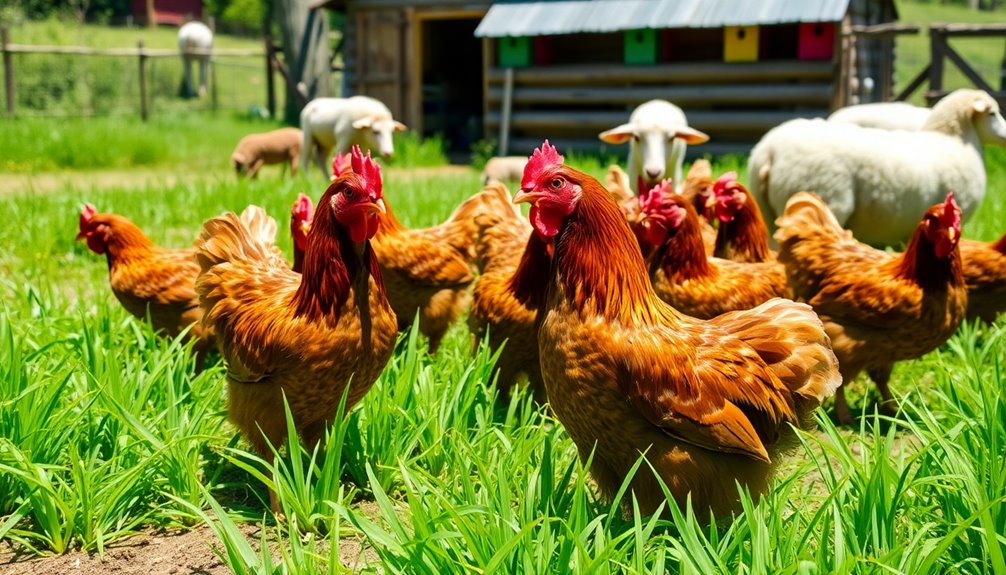
Raising dual-purpose chickens offers a range of benefits that can greatly enhance your homestead's productivity. These breeds provide both good meat and a reliable supply of eggs, allowing you to meet multiple needs with a single flock. For example, breeds like the Rhode Island Red and Buff Orpington can lay up to 280 eggs per year. Additionally, they are excellent foragers, reducing your reliance on commercial feed and lowering overall costs. With dual-purpose chickens, you can enjoy the advantages of fresh eggs and quality meat while promoting sustainable farming practices.
| Benefit | Description | Example Breeds |
|---|---|---|
| Egg Production | Laying eggs consistently | Rhode Island Red |
| Meat Quality | Producing good meat | Buff Orpington |
| Foraging Ability | Excellent foragers | Sussex |
Factors for Choosing Chicken Breeds
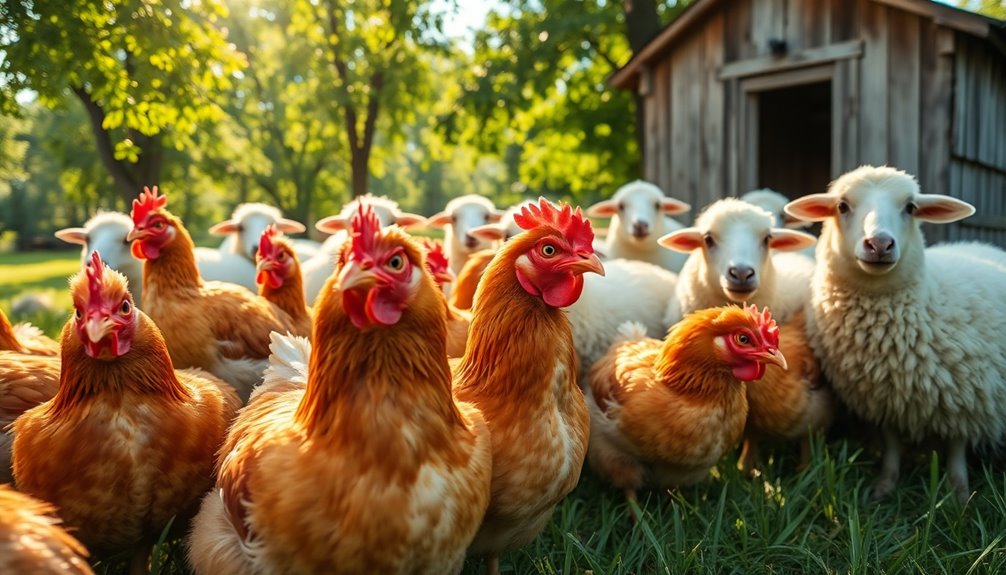
Selecting the right chicken breeds for your homestead involves several key factors that can greatly impact your flock's productivity.
First, consider the laying age; most dual-purpose breeds begin laying eggs between 4 to 7 months, affecting your egg production timeline.
Evaluate the egg production capabilities, as some breeds, like Black Australorps, can yield up to 364 eggs annually.
Additionally, pay attention to processing age; dual-purpose breeds typically take 16 to 22 weeks to reach suitable meat size.
Mature weight also matters, with these chickens averaging between 5 to 13 pounds, influencing meat yield.
Finally, a breed's foraging ability can enhance sustainability, allowing chickens to supplement their diet through free-ranging, which helps lower feed costs.
Popular Dual-Purpose Chicken Breeds
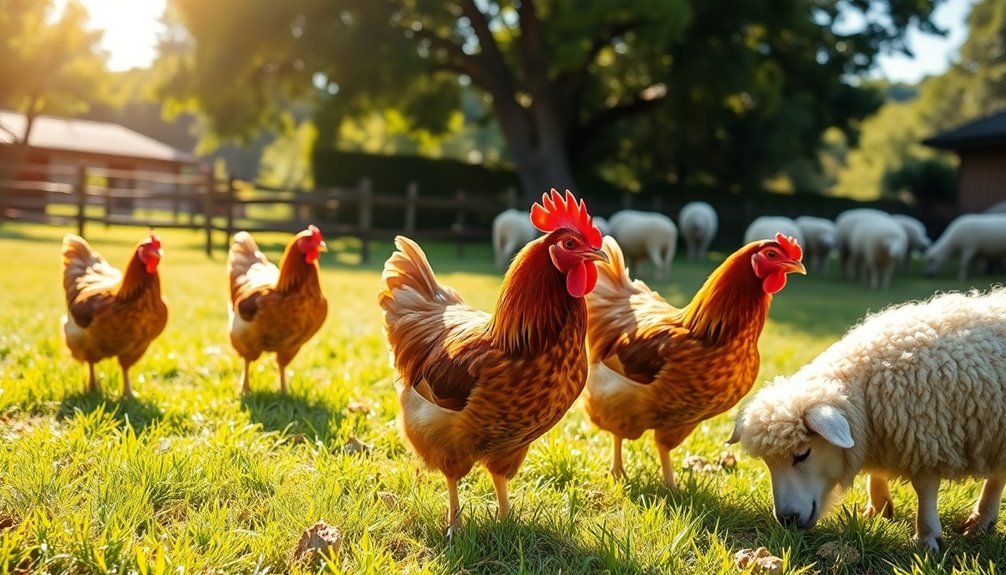
What makes dual-purpose chicken breeds so popular among homesteaders? These breeds provide reliable meat and egg production, maximizing your homestead's productivity. Here are some of the top dual-purpose breeds you might consider:
| Breed | Egg Production (per year) | Weight (lbs) |
|---|---|---|
| Rhode Island Red | 200-300 | 6-8 |
| Plymouth Rock | 260 | 7 |
| Buff Orpington | 250-280 | 8-10 |
| Brahma | 200 | 9-12 |
| Delaware | 200 | 6.5-8 |
With their hardiness and adaptability, breeds like the Rhode Island Red and Buff Orpington can thrive in various environments, making them perfect choices for your homestead.
Raising Chickens for Eggs
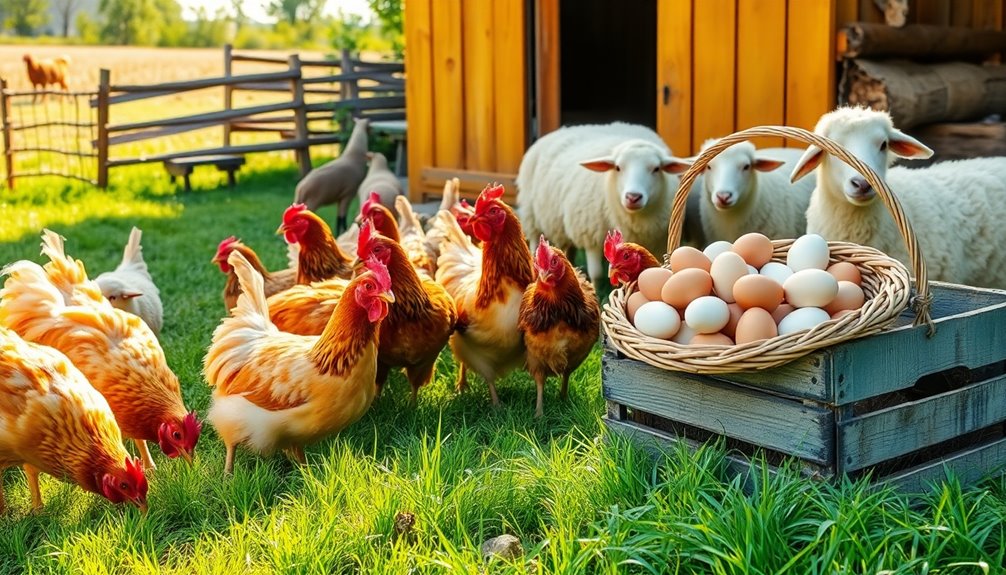
When raising chickens for eggs, it's essential to understand their production rates and the ideal conditions they need to thrive.
Choosing the right breed can greatly impact your egg yield and consistency throughout the year.
Egg Production Rates
For those interested in raising chickens for eggs, understanding egg production rates is essential.
Dual-purpose chicken breeds offer a reliable, though slightly lower, egg yield compared to specialized layers. Breeds like the Black Australorp can produce up to 364 eggs annually, making them a good choice for consistent egg supply.
Typically, these hardy breeds start laying around 4 to 7 months of age, ensuring a quick return on investment. Buff Orpingtons lay about 250-280 eggs per year, while Plymouth Rocks produce around 220-280 eggs.
The colors of the eggs can vary, with many dual-purpose breeds laying large brown eggs. By selecting the right breed, you can enjoy a steady supply of fresh eggs throughout the year.
Ideal Laying Conditions
Creating ideal laying conditions for your chickens is essential to maximizing egg production and guaranteeing their overall health. To achieve this, focus on these key factors:
- Lighting: Guarantee your coop has around 14-16 hours of light daily, especially in winter, to help your dual-purpose hens lay good eggs consistently.
- Diet: Provide a balanced diet rich in protein and calcium. A nutritious diet supports your hens' health and boosts egg yield.
- Environment: Maintain a comfortable coop temperature. Cold-hardy breeds like Buff Orpingtons thrive in lower temps, guaranteeing year-round egg availability. Additionally, consider that early morning hours can influence the overall laying frequency and behavior of your hens.
Breed Selection Factors
Selecting the right breed for egg production involves several important factors that can greatly impact your success.
When raising chickens for eggs, consider the laying age; many dual-purpose breeds, like Wyandottes and Buff Orpingtons, start laying between 4-7 months.
Egg production varies, with the Black Australorp being a standout, potentially producing up to 364 eggs annually.
Pay attention to the mature weight of the breed, as heavier chickens like Brahmas may have different nutritional needs than lighter layers.
Additionally, breeds that forage well, such as Plymouth Rocks and Rhode Island Reds, can help reduce feed costs.
Finally, choose breeds known for temperature hardiness, like the Wyandotte, to guarantee consistent egg production throughout the year.
Raising Chickens for Meat
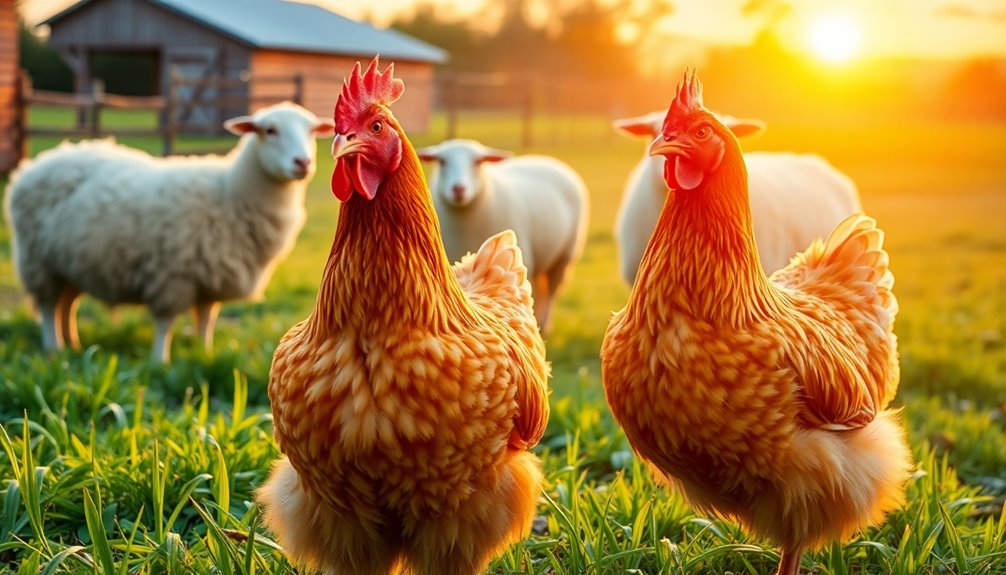
Raising chickens for meat offers a rewarding blend of sustenance and satisfaction. By choosing dual-purpose breeds like the Buff Orpington and Black Australorp, you can enjoy both meat and egg production.
Here are three key benefits of raising meat birds:
- Economical Processing: Dual-purpose roosters can often be sourced cheaply and provide steady meat supplies.
- Flavorful Meat: The meat from these breeds is richer compared to specialized broilers, making it ideal for slow cooking methods.
- Sustainable Egg Production: Breeds like the Black Australorp can lay up to 364 eggs per year, enhancing your homesteading efforts.
With processing typically occurring between 16-24 weeks, you'll have a delicious and sustainable food source right at home!
Dual-Purpose Sheep Breeds
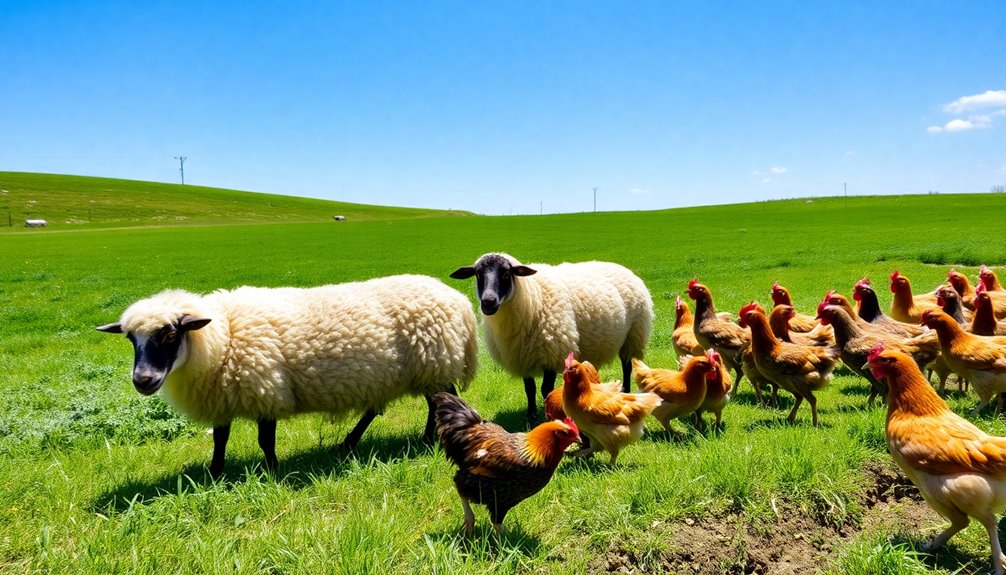
If you've enjoyed the benefits of raising chickens for meat, you might find dual-purpose sheep breeds equally rewarding.
These breeds provide both quality meat and other products, making them a fantastic addition to your farm. The Awassi sheep, for instance, offers good milk and wool, although they may be hard to find in some areas.
Icelandic sheep are great for tri-purpose production, giving you wool, meat, and enough milk for a small family.
While East Friesian sheep shine in dairy production, crossbreeding enhances their meat quality in a dual-purpose context.
When choosing a dual-purpose breed, maintaining purity is essential for preserving desirable traits.
It's good to know that focusing on one breed can boost your marketability and efficiency!
Practical Considerations for Sheep Farming
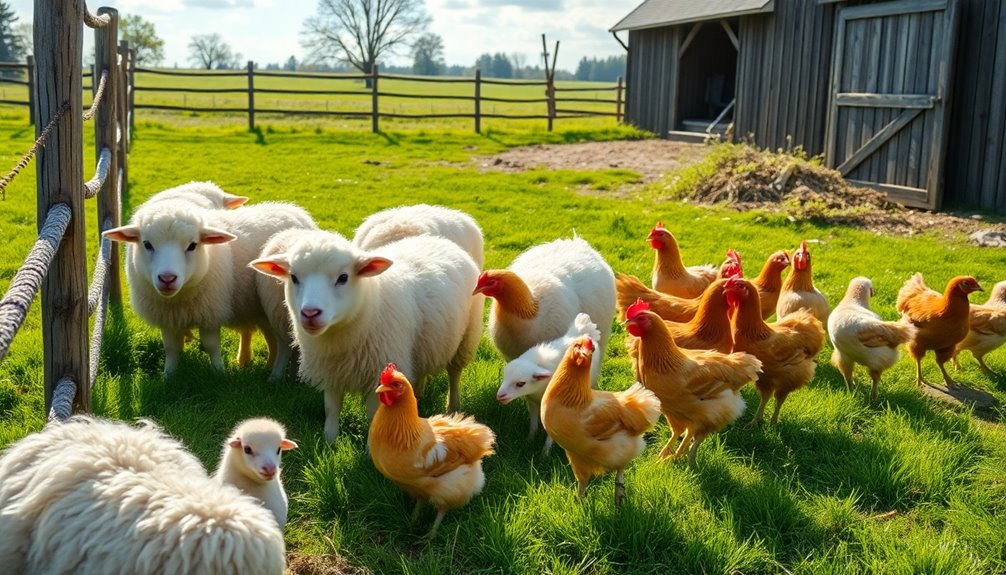
When it comes to sheep farming, having a solid understanding of practical considerations can make all the difference in your success.
Here are three key points to keep in mind:
- Know Local Market Demands: Identify what consumers are looking for in sheep—whether it's specific meat breeds or wool qualities. This helps you select the right sheep for your farm.
- Provide Proper Shelter and Nutrition: Guarantee your flock has proper shelter to protect them from harsh weather. A balanced diet is vital for their health and productivity, especially if you're raising them for eggs and meat.
- Continuous Learning: Attend workshops to enhance your sheep management skills. This knowledge will help you effectively care for your flock and respond to challenges.
Frequently Asked Questions
What Is the Best Dual Purpose Chicken?
When you're looking for the best dual-purpose chicken, you can't go wrong with the Buff Orpington. It lays around 250-280 eggs per year and grows to a mature weight of 8-10 pounds, making it great for meat too.
If you want a hardier option, consider the Rhode Island Red, which also excels in egg production and meat quality.
Each breed offers unique benefits, so pick one that suits your needs!
Which Two Breeds of Chicken Are Dual Purpose Raised for Meat and Eggs )?
Choosing dual-purpose chickens is like picking a trusty toolbox; you want versatility.
The Rhode Island Red and Plymouth Rock are two excellent breeds for both meat and eggs. The Rhode Island Red lays between 200 to 300 eggs annually and offers quality meat, while the Plymouth Rock produces around 220 to 280 large brown eggs and weighs 7-10 pounds.
Both breeds thrive in various environments, making them perfect additions to your homestead.
Are Dual Purpose Chickens Worth It?
Yes, dual-purpose chickens are definitely worth it! They provide you with both meat and eggs, maximizing your resources on a small farm or homestead.
With breeds like Rhode Island Reds or Plymouth Rocks, you can enjoy a steady supply of eggs while also having quality meat.
Plus, their foraging ability helps reduce feed costs. Their adaptability to various climates and natural broodiness makes them a sustainable choice for your poultry needs.
Which Breed of Chicken Are Useful for Obtaining Eggs and Meat?
Imagine strolling through a sunlit farm, greeted by clucking friends who not only lay eggs but also provide hearty meals.
If you're seeking dual-purpose chickens, consider the Rhode Island Red or Buff Orpington. They offer a bounty of eggs while growing into substantial birds for meat.
Plymouth Rocks and Wyandottes are friendly choices too, balancing egg-laying and meat production.
With these breeds, you'll enjoy the best of both worlds in your backyard!
Conclusion
In the world of livestock, dual-purpose breeds are like a well-crafted symphony, harmonizing the benefits of both meat and eggs or wool. By choosing the right chickens and sheep, you're not just diversifying your farm; you're creating a balanced ecosystem that provides sustenance and joy. Embrace the versatility of these breeds, and you'll find that raising them is both rewarding and efficient. With a little care, your farm can thrive in perfect rhythm.

